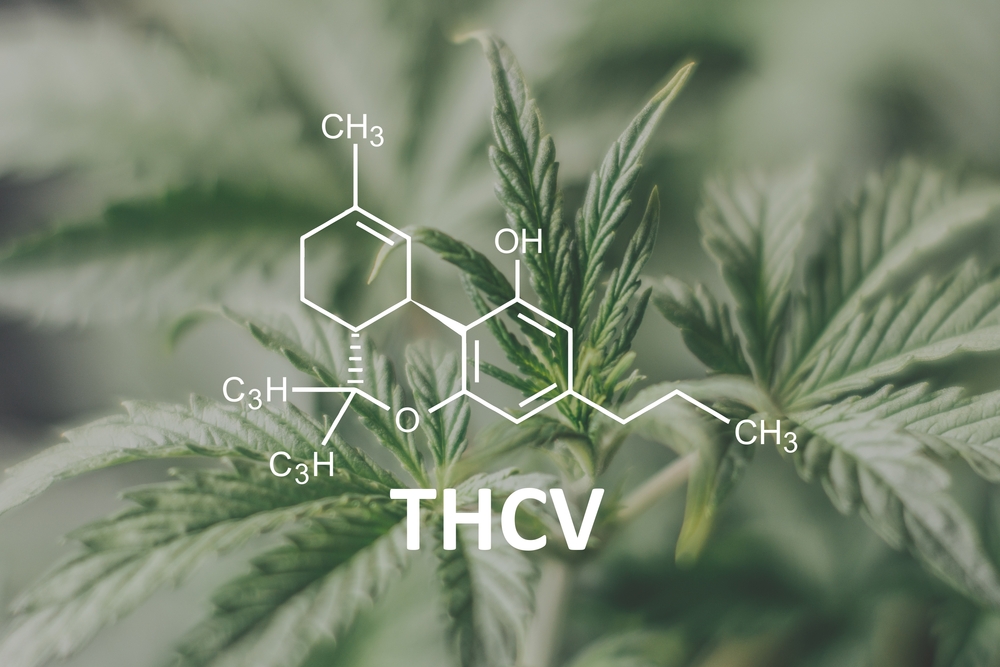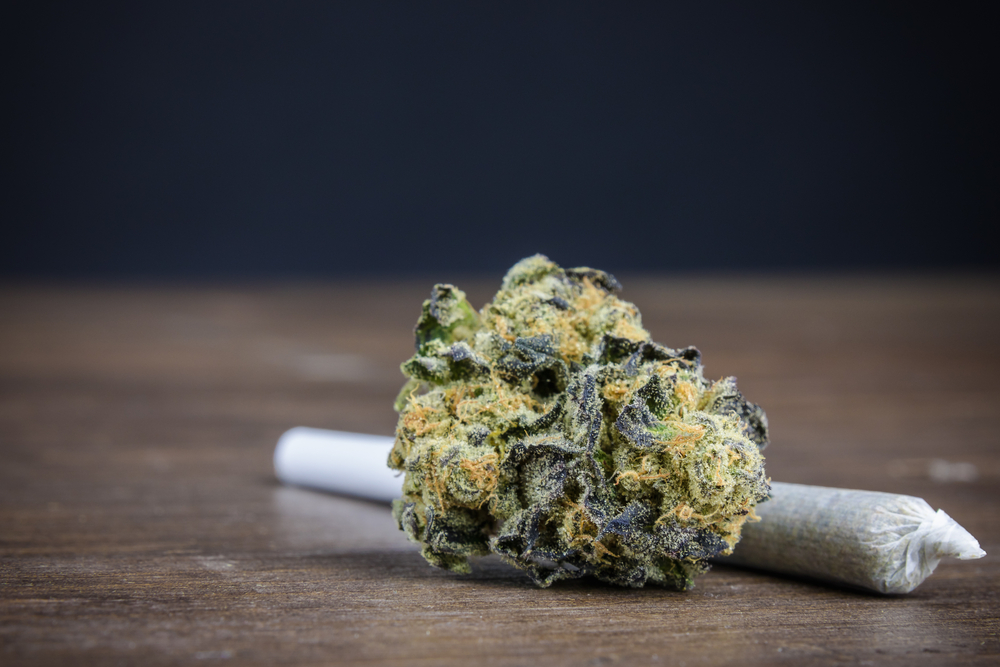Table of Contents
Introduction
Tetrahydrocannabivarin, often known as THCV, is a naturally occurring substance found in cannabis plants. Along with well-known substances like THC (tetrahydrocannabinol) and CBD (cannabidiol), it is one of the many cannabinoids found in the cannabis plant.
Due to its distinct characteristics and possible medicinal uses, THCV has drawn attention. Research on THCV has increased recently, giving light to its unique pharmacology and potential health advantages.

Brief Explanation of THCV
THCV is a cannabinoid that shares a similar molecular structure to THC, the primary psychoactive compound in cannabis. However, THCV has different effects and properties compared to THC. It is found in varying concentrations in different cannabis strains, with some strains having higher levels of THCV than others.
THCV interacts with the endocannabinoid system (ECS) in the human body, which plays a crucial role in maintaining balance and regulating various physiological functions. Like other cannabinoids, THCV binds to cannabinoid receptors in the ECS, primarily CB1 and CB2 receptors. However, THCV exhibits a unique binding affinity and activates these receptors differently than THC.
Research suggests that THCV may have potential therapeutic uses in various areas. It has been studied for its potential effects on weight management and appetite suppression, making it of interest for conditions like obesity and metabolic disorders. THCV has also shown promise in diabetes management, potentially helping regulate blood sugar levels. Additionally, it has been explored for its neuroprotective properties and its potential in treating neurodegenerative diseases. Other areas of interest include mood and anxiety regulation.
It is worth noting that THCV can have psychoactive effects, although they differ from the euphoric “high” typically associated with THC. THCV is known for its potential energizing and uplifting effects, and its impact on mood and cognition may vary from person to person.
Importance of THCV in the Context of cannabis compounds
THCV holds significant importance in the context of cannabis compounds due to its distinct pharmacological properties and potential therapeutic applications. As researchers delve deeper into the complexities of the cannabis plant, they are discovering that cannabinoids like THCV can offer unique effects and benefits beyond the well-known THC and CBD.
THCV’s potential in areas such as weight management, diabetes regulation, neuroprotection, and mood modulation has sparked interest among scientists, healthcare professionals, and cannabis enthusiasts alike. Its different binding affinity to cannabinoid receptors and its varying psychoactive effects set it apart from other cannabinoids, providing a rich field for exploration and potential therapeutic innovations.
Understanding the potential of THCV and its interactions within the complex web of the endocannabinoid system may pave the way for novel therapeutic approaches and contribute to a more comprehensive understanding of cannabis and its diverse compounds.
Background on THCV
Natural occurrence and sources of THCV
THCV (Tetrahydrocannabivarin) is a naturally occurring compound found in cannabis plants. While it is present in smaller quantities compared to other cannabinoids like THC and CBD, certain cannabis strains have been found to contain relatively higher levels of THCV. The concentrations of THCV can vary significantly depending on the genetics of the plant and environmental factors during cultivation.
Various cannabis strains have been identified as potential sources of THCV. Some African landrace strains, particularly those originating from countries such as South Africa, Swaziland, and Malawi, are known to have higher levels of THCV. These strains include Durban Poison, which is famous for its uplifting effects and potential THCV content. Other strains like Doug’s Varin, Jack the Ripper, and Pineapple Purps have also been reported to contain notable amounts of THCV.
It is worth noting that the overall composition of cannabinoids in cannabis can be influenced by factors such as cultivation techniques, growing conditions, and genetic variability. Consequently, the THCV content can differ even among plants of the same strain.
The natural occurrence of THCV in cannabis plants has attracted attention due to its potential therapeutic benefits. As the cannabis industry evolves and scientific understanding of cannabinoids expands, efforts are underway to breed cannabis strains with elevated THCV levels. This allows for more consistent access to THCV-rich varieties and facilitates further research into its potential benefits. However, it’s important to note that the availability of THCV-rich strains may vary depending on local regulations and the specific market.

Historical and cultural significance of THCV
The historical and cultural significance of THCV (Tetrahydrocannabivarin) in the context of cannabis is a fascinating aspect to explore. Cannabis has been used by various cultures throughout history for its diverse properties, including its potential psychoactive and medicinal effects. While THCV is not as well-known as other cannabinoids, it holds a unique place in the historical and cultural narrative of cannabis use.
In certain regions of Africa, where cannabis has a long history of cultivation and use, strains high in THCV have played a significant role in traditional practices and cultural rituals. For instance, in parts of South Africa, cannabis strains like Durban Poison, known for their higher THCV content, have been used by indigenous communities for centuries. These strains have been valued for their uplifting and stimulating effects, and they hold cultural significance as part of spiritual ceremonies and social gatherings.
THCV-rich cannabis strains have also found their place in the historical and cultural practices of other regions. In countries like Malawi and Swaziland, cannabis varieties with higher THCV content have been part of traditional medicine and cultural traditions. The unique properties of THCV, including its potential energizing and appetite-suppressing effects, have made it an intriguing component in the diverse pharmacopeias of these cultures.
Furthermore, the exploration of historical texts and ancient manuscripts reveals the presence of cannabis-related practices that may have involved THCV-rich strains. From ancient Egyptian texts to traditional Ayurvedic medicine in India, cannabis has been referenced for its potential therapeutic applications. Although specific mentions of THCV might be less prevalent, these historical accounts highlight the broader cultural significance of cannabis and its potential compounds in various societies.
In recent years, as the scientific understanding of cannabinoids has expanded, researchers and cannabis enthusiasts have rediscovered the historical significance of THCV-rich strains. With the resurgence of interest in these unique cannabis chemovars, there has been a renewed appreciation for the historical knowledge and cultural practices that have recognized the distinct effects of THCV.
Understanding the historical and cultural significance of THCV allows us to appreciate the complex relationship between cannabis and human societies throughout time. It also highlights the interconnectedness of plant medicine, cultural traditions, and the ongoing exploration of cannabinoids. As research and cultural awareness continue to evolve, the historical and cultural significance of THCV serves as a reminder of the rich tapestry of human-plant interactions and the untapped potential that lies within cannabis and its diverse compounds.
Pharmacology of THCV
Interaction with the endocannabinoid system
THCV interacts with a fascinating system in our bodies called the endocannabinoid system (ECS). The endocannabinoid system is a complex network of receptors, enzymes, and endocannabinoids that helps regulate various physiological functions and maintain balance, or homeostasis, in our bodies.
When we consume THCV, it interacts with the endocannabinoid receptors in our body. The two main types of receptors that THCV acts upon are known as CB1 and CB2 receptors. These receptors are found throughout our body, with CB1 receptors primarily located in the brain and central nervous system, while CB2 receptors are more abundant in the peripheral tissues, including the immune system.
THCV has a unique interaction with these receptors. It binds to them and activates them, but the way it binds and activates the receptors is different from other cannabinoids like THC. This interaction with the CB1 and CB2 receptors can have various effects on our body’s functions.
Moreover, THCV can also affect other molecular targets in addition to the cannabinoid receptors. It may influence certain neurotransmitters, such as dopamine and GABA, which play important roles in regulating mood, appetite, and motor control.
The precise effects of THCV on the endocannabinoid system and other molecular targets are still being studied, and researchers are working to unravel the complexities of this interaction. This research is crucial for understanding the potential therapeutic applications of THCV and how it may be beneficial in various health conditions.
By interacting with the endocannabinoid system, THCV has the potential to modulate various physiological processes and promote balance within the body. However, it’s important to note that the effects of THCV can vary from person to person, and more research is needed to fully understand its specific mechanisms of action and how it may benefit different individuals. Overall, the interaction between THCV and the endocannabinoid system showcases the intricate relationship between certain compounds found in cannabis and our body’s natural regulatory system.

Binding affinity to cannabinoid receptors (CB1 and CB2)
THCV interacts with the body’s endocannabinoid system by binding to cannabinoid receptors, specifically CB1 and CB2 receptors. These receptors are part of a larger class of receptors known as G protein-coupled receptors (GPCRs), which are involved in transmitting signals within cells.
When THCV enters the body, it attaches itself to CB1 and CB2 receptors, initiating a series of biochemical reactions. The binding affinity refers to the strength with which THCV attaches to these receptors.
THCV has a unique binding affinity to cannabinoid receptors compared to other cannabinoids like THC or CBD. While THC has a high binding affinity to CB1 receptors, resulting in its well-known psychoactive effects, THCV has a lower binding affinity to CB1 receptors. This means that it does not strongly bind to CB1 receptors, leading to different effects.
In contrast, THCV has a higher binding affinity to CB2 receptors. CB2 receptors are mainly found in the immune system and peripheral tissues. By binding to CB2 receptors, THCV may exert its effects on immune response, inflammation, and other functions related to the immune system.
The differing binding affinity of THCV to CB1 and CB2 receptors contributes to its unique properties and potential therapeutic applications. The lower binding affinity to CB1 receptors means that THCV is less likely to induce the typical psychoactive effects associated with THC. Instead, THCV may have different effects on mood, cognition, and appetite regulation, which are areas of ongoing research.
It’s important to note that the binding affinity of THCV to cannabinoid receptors is just one factor influencing its overall effects. Other factors, such as dosage, individual physiology, and the presence of other cannabinoids or compounds, can also impact the overall response to THCV.
Further research is needed to fully understand the precise mechanisms by which THCV interacts with CB1 and CB2 receptors and how these interactions contribute to its potential therapeutic effects. Investigating the binding affinity of THCV to cannabinoid receptors is a crucial step in unraveling the complex interactions between cannabinoids and the endocannabinoid system, ultimately leading to a deeper understanding of their therapeutic potential.
Potential Medical Uses of THCV
Weight management and appetite suppression
THCV (Tetrahydrocannabivarin) has shown promise in the area of weight management and appetite suppression. Research suggests that THCV may have the ability to affect appetite and body weight through its interactions with the endocannabinoid system and other molecular targets.
One of the unique properties of THCV is its potential to suppress appetite. It is believed to influence certain brain pathways involved in appetite control, specifically by interacting with cannabinoid receptors in the central nervous system. By binding to these receptors, THCV may modulate the release of certain neurotransmitters and hormones that play a role in regulating hunger and satiety.
Several studies conducted on THCV have demonstrated its potential to reduce food intake and decrease appetite. It is thought that THCV may act as an antagonist to the CB1 receptor, meaning it can block or reduce the activation of these receptors by other cannabinoids. By doing so, THCV may counteract the hunger-inducing effects of other compounds, potentially leading to a decrease in food cravings and overall caloric intake.
Moreover, THCV’s potential role in weight management extends beyond appetite suppression. Research suggests that THCV may have metabolic effects that contribute to weight regulation. Some studies indicate that THCV may enhance the function of mitochondria, the energy-producing powerhouses of cells, thereby increasing energy expenditure and promoting fat breakdown.
Furthermore, THCV may have a favorable impact on glucose and insulin regulation. It has been observed to improve glucose tolerance and increase insulin sensitivity in preclinical studies. These effects are of particular interest in the context of weight management, as insulin resistance and impaired glucose metabolism are often associated with obesity and metabolic disorders.
It’s important to note that while the preliminary findings on THCV’s potential role in weight management are promising, more research is needed to fully understand its mechanisms of action and its efficacy in human subjects. Clinical trials with larger sample sizes and longer durations are necessary to validate these findings and establish appropriate dosing guidelines for specific weight management purposes.
Additionally, it’s crucial to approach the use of THCV or THCV-rich products for weight management under the guidance of healthcare professionals or experts knowledgeable in cannabinoid therapies. The legal status and availability of THCV-rich products may vary, and individual responses to THCV can vary as well.
In conclusion, THCV shows potential as a compound that may aid in weight management and appetite suppression. Its interactions with the endocannabinoid system and potential effects on appetite-regulating pathways make it an intriguing area of research. However, further studies are required to fully elucidate its mechanisms and determine its effectiveness as a therapeutic option for weight management.
Diabetes management and blood sugar regulation
Tetrahydrocannabivarin (THCV) has demonstrated promise in the treatment of diabetes and control of blood sugar. THCV may improve insulin sensitivity and glucose metabolism, making it a possible treatment choice for those with diabetes or prediabetes.
According to studies, THCV can improve glucose tolerance and the function of pancreatic cells that produce insulin, helping to control blood sugar levels. THCV may contribute to healthy blood sugar regulation and metabolic health by interacting with the endocannabinoid system and other molecular targets.
To create suitable dose recommendations for therapeutic application and completely comprehend the precise processes underlying THCV’s activities in the control of diabetes, additional study is necessary.
Neuroprotective properties and potential for treating neurodegenerative diseases
THCV (Tetrahydrocannabivarin) exhibit potential neuroprotective properties, making it an intriguing candidate for the treatment of neurodegenerative diseases. Research suggests that THCV may have antioxidant and anti-inflammatory effects, which can help protect neurons from damage and reduce inflammation in the brain.
These properties make THCV a potentially valuable compound in mitigating the progression of neurodegenerative conditions such as Parkinson’s disease and Alzheimer’s disease. While preclinical studies have shown promising results, further research and clinical trials are needed to fully understand the therapeutic potential of THCV in neurodegenerative diseases and to determine the appropriate dosing and delivery methods for effective treatment.

Mood and anxiety regulation
While THCV is an intriguing cannabinoid with potential effects on mood and anxiety regulation, it’s important to note that other non-THCV compounds found in cannabis can also play a role in this regard. CBD (cannabidiol) is one such compound that has gained significant attention for its potential therapeutic effects on mood and anxiety disorders.
CBD has been studied for its anxiolytic properties, with research indicating its ability to reduce anxiety and promote a sense of calmness. Additionally, CBD may have mood-stabilizing effects, potentially helping to alleviate symptoms of depression. Its interactions with the endocannabinoid system and other molecular targets in the brain are thought to contribute to its beneficial effects on mood and anxiety regulation.
As research on the various compounds found in cannabis continues to expand, we gain a deeper understanding of how these non-THCV cannabinoids can be harnessed for their potential therapeutic benefits in mental health.
THCV affects the Body
THCV (Tetrahydrocannabivarin) exhibits a range of effects on the body, primarily through its interactions with the endocannabinoid system. THCV may have both similar and distinct effects compared to other cannabinoids like THC and CBD. THCV has been found to interact with cannabinoid receptors, particularly CB1 and CB2 receptors, although its binding affinity and effects on these receptors may differ from THC.
One area where THCV shows potential is in appetite regulation and weight management. Unlike THC, which is known to increase appetite, THCV has been found to potentially suppress appetite. It is believed that THCV acts as an antagonist to the CB1 receptor, which can reduce the activation of these receptors by other cannabinoids. This may lead to a decrease in food cravings and overall caloric intake. Furthermore, THCV has been found to potentially enhance mitochondrial function, the energy-producing organelles within cells, which can increase energy expenditure and promote fat breakdown.
Preclinical studies have suggested that THCV may possess anti-inflammatory properties, indicating its potential in mitigating inflammation-related conditions such as inflammatory bowel disease. Furthermore, THCV has shown anticonvulsant properties, suggesting its potential as an adjunctive treatment for epilepsy and seizure disorders.
Moreover, THCV may have implications for glucose and insulin regulation. It has been observed to improve glucose tolerance and increase insulin sensitivity in preclinical models. These effects are particularly relevant in the context of metabolic disorders such as diabetes and obesity.
Side effects and safety considerations
While THCV (Tetrahydrocannabivarin) shows promise as a potential therapeutic compound, it’s important to consider its side effects and safety profile. Limited research is available on the specific side effects of THCV, as most studies have focused on THC and CBD.
However, it’s worth noting that some individuals may experience side effects similar to those associated with cannabis use, such as dry mouth, dizziness, and changes in appetite. Additionally, since THCV can interact with the endocannabinoid system, it may have psychoactive effects in higher doses, potentially leading to feelings of anxiety or disorientation.
Safety considerations should also take into account the variability of THCV content in cannabis strains and products, as well as potential drug interactions. As with any new treatment, it’s crucial to consult with healthcare professionals and adhere to appropriate dosing guidelines to ensure safety and minimize potential risks associated with THCV use.
Conclusion
In conclusion, THCV (Tetrahydrocannabivarin) is a fascinating cannabinoid compound found in cannabis plants that hold significant potential for various therapeutic applications.
Its effects on the body, such as appetite suppression, weight management, potential anti-inflammatory properties, and its interaction with the endocannabinoid system, make it an intriguing subject of scientific research. While THCV shows promise, further studies are needed to fully understand its mechanisms of action, optimal dosing, and potential long-term effects.
Safety considerations should be taken into account, and consultation with healthcare professionals is crucial for appropriate use. As research continues to unfold, THCV may present new opportunities for the development of novel therapies and treatments for a range of conditions.
With ongoing exploration and advancements in the field of cannabinoid research, THCV holds the potential to contribute to our understanding of the intricate interplay between cannabinoids and the human body, opening doors to innovative approaches in healthcare and wellness





